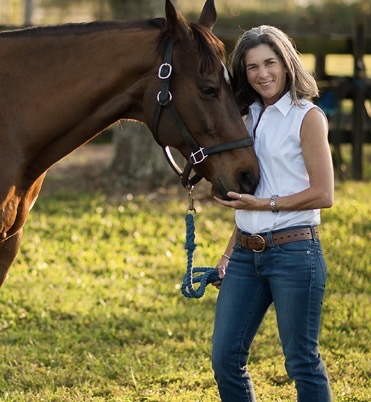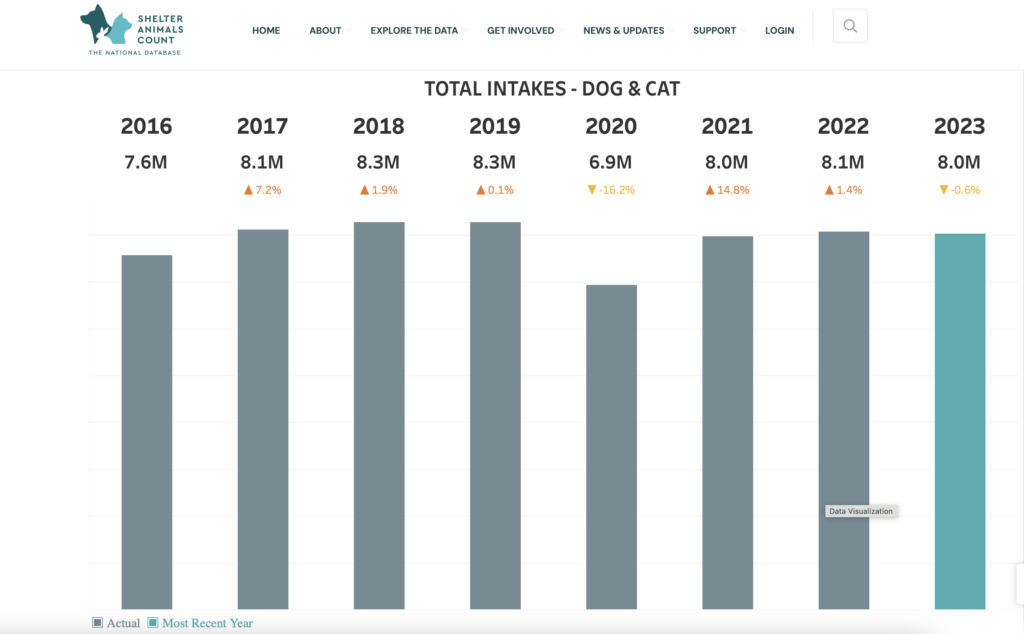News, ideas & inspiration from industry leaders

It’s Not All Going to Sh*t
Dr. Emily Weiss poses an alternative to feeling overwhelmed and hopeless about the state of animal sheltering

The other day I saw yet another article focusing on the crisis in shelters. There were interviews with shelter staff, who revealed how they were deeply saddened, feeling hopeless and completely overwhelmed by what was happening in their communities. The sheltering data was showing the data going the wrong way compared to 2021 and 2022.
I pulled up the latest report from Shelter Animals Count and I noted intake is still down 3% compared to 2019 (the last “regular” year prior to the pandemic), live outcomes were up by 75,000 animals compared to 2019, and euthanasia is down 16% from 2019. Yes, dog euthanasia is up a bit from 2019 and has been trending up the last couple years – which may or may not be an indicator of something).
I know everyone is working their tails off, and folks are feeling like there is a huge backslide and there is no getting out of it. I know that feeling really f****** sucks. But maybe there is a different set of glasses we can put on to help us get ahead of the curve here.
Back in 2019, many of us in sheltering were feeling optimistic about where the field was headed. Euthanasia was down, adoptions up, s/n programs were growing, community programs growing, and an increasing number of shelters had the room, resources, and time to focus on some of the most challenging populations in their shelters.

Then the pandemic hit and…believe it or not, it was a sheltering Nirvana! So many groups dug in, anticipating a big influx of animals at the beginning of the pandemic, and added resources – fundraising, community engagement and planning for what we thought was going to be a huge influx of animals… but instead, intake went from 8.3M in 2019 to 6.9M in 2020! Adoption rates went through the roof. Many shelters really had time to focus on the most challenging populations, as their doors were closed to the public.
It was easy to get used to the “new normal” – which, we now know, was not really a new normal but instead a pause in the actual normal. So now we find ourselves with shelter data that is similar (but, for most cases, still better) than what was happening in shelters in 2019 when we were optimistic about where we were heading!
I would like to suggest something. Things are not going to sh*t. We got this. We have been here before. While the pandemic left us with some significant hiccups we need to noodle through—including the effects of the gap in s/n services, the undersocialized 2ish-year-old dogs entering shelters, options for dogs, and staffing issues —we have been here before. And we have the tools to continue toward improving trends.
Yes – we are seeing some data that should make us want to dig to understand the “why.” Why is dog euthanasia up? Why are we seeing an increase of animals in care (among others)? Community data is vital here to get the full picture, and looking at data points in your community can help. We will dig into a couple of the potential “Why” questions in future blogs. But for now, I suggest you suspend the notion that we are falling down a bottomless hole and instead pick up that curiosity and optimism you may have left at 2022’s doorstep. Because together, we got this!
What’s the most pressing challenge you’re experiencing at your shelter right now? Leave a comment and tell us more. Dr. Weiss will use your feedback to inform the topics of future blogs on this theme.



She’s baaack!!
We all need a good solid dose of Doc Em logic!
What challenge am I facing?
Our local municipal shelter fanning the flames of over-capacity drama while not engaging in pathway planning, declining owner surrenders because they are not required to accept them by NC law, and relying on my agency to transfer in sick and behaviorally challenged animals from them – there’s public pressure to do this due to their public outcries. Another change is animal welfare professionals were considered hero’s when I started in this field. We were thanked. Respected. I believe there’s been a movement toward casting doubt and suspicion on shelters. Questioning motives and intent. Not trusting outcome decisions and data. This shift makes me sad.
Hello Ellen!!
Thank you for sharing your challenges – When I read what you have written it sounds like perceptions from the public are a major driver. This may be another reason for us to shift the narrative nationally and locally- the public too may have lost their optimism.
Our biggest challenges: Massive increase in requests to surrender dogs, mostly with behavioural issues; an increase in requests to surrender older cats as a generation of owners move in with other family members or long term care; an increase in the number of puppies needing homes.
Thank you Nadine for sharing your challenges. As so many folks added pets to their lives, there will naturally be a percentage unable to keep their pets. I am curious about the behavioral issues – with the lack of socialization options during the pandemic we would anticipate seeing 2-3 year old dogs with emotional control issues, arousal issues and fear issues. Is that what you are seeing? Do you have any data on those dogs? Interesting to hear about the older cat surrenders – sounds tragic for folks to be stripped from their animals right when they need them most – I wonder if there is an opportunity there!! Exciting to think about ways to keep them together!
Thank you Emily! It is easy, especially for those newer to the field, to forget how far we have come. I started as a volunteer in 1990 and have been working full-time in the field since 2003 and believe me, this is not the worst it has been. We are headed in the right direction, but ups and downs happen. Progress is not linear, ups and downs have to be expected. All we can do is keep on going, educating the public, promoting spay and neuter, and placing as many animals as we can responsibly place. If we keep doing those things we will get past this.
Peggy! Yes!!! We know how to fix this! And for the new emerging issues, we simply need to start with “why” and add a dose of “how do you know” – we will get there!
Thank you for a breath of hope and optimism. It is indeed hard right now. It’s been hard before and it’s been hard again.
We need to take care of each other, those we’re entrusted with, and our communities as best we can. We’ve got this.
Hi Dr. Weiss
Hopefully, your positivity will unite people to solve the problems we’ve seen with pet ownership and relinquishment so we see more pets with positive outcomes and fewer pets euthanized. There’s nothing more heartbreaking than an adoptable pet being euthanized through no fault of their own.
I work for two new 501(c)3 nonprofit organizations: Edwin D Marks Animal Foundation and Guardian Pet Trust. Our mission is to spread awareness about Pet Trusts. Pet Trusts are a great way to protect your pet’s future if you can no longer care for your pet due to illness, injury, or death. They enable your pet to be rehomed with directions for their care to maintain their current lifestyle. Pet Trusts help keep pets with their families while the pet owner is alive or rehome them, if the pet owner is not.
Our long-term hope is that as more people prepare Pet Trusts, fewer pets will wind up in shelters due to their owner’s inability to care for them. This will reduce the spread of illness and lead to less overcrowding and fewer euthanizations. It’s one small but, hopefully, growing solution to the problems facing shelters today.
As you said, “because together, we got this!”
Debra! Thank you for sharing this. What a great way to help change the perspective for the public – and to give peace of mind to those that are faced with the most impossible of situations. You will see a comment above where a shelter is seeing an increase in older cat intakes due to individuals moving to long term care. Trusts are a great solution for those with the resources to do so.
Could there be an arm to one of those organizations to fundraise to provide trusts for those who can’t afford to do so? How lovely would it be to have a community resource for those who are not fortunate enough to set up a trust for their pets. If something can be set up, I will be among the first to donate!
Finally!!! Thank you so much for voicing what many of us have been thinking. There are great people in this industry with incredible passion and vision. This may feel like a bump in the road, but it’s a bump, not a colassal mountain. We must look around and look at all of the good that is happening and not forget to rejoice in that. Thank you, Dr. Weiss!
Very well said Gina!!
We are all getting older. Five years is a huge difference in our abilities. If we could find some 40 & 50 year olds to join our team and take on some of the larger responsibilities we would not feel as defeated! We are all 65+ to 70+. We do not have much time left, considering we’ve all been doing this for 15 years already. Yeah, we’ve TNR’d almost 15,000 cats in that time but we are not done!
Tammy! 15,000 cats! Woot! Congratulations. Have you thought about an intern program where young, animal passionate folks could see a career path? What a great legacy you can share!
Hello Emily,
Your blog, It’s Not All Going to Sh*t is for sure a light in this dark period of animal welfare. A while back I did a bit of research and wrote an article on the pandemics positive effects on animal shelters and the bleak rebound. I had associated the mass of people shifting from work to home to back to work with these numbers. It’s definitely reassuring that all is not lost.
Thanks for sharing.
Warm regards,
Julie Marinelli
Seconding @Ellen Taylor’s comments above, great to see Dr Weiss back in the conversation. From an Australian perspective I think everything you have said holds true for us as well. Unfortunately we don’t have the collective data to support this but having been in the field for 30+ years I sure am glad that it is 2024 and not 1994 🙂
I have been working in this field since 1985. When national grants began to be available (PetSmart, Petco, Maddie’s Fund) for spaying and neutering, we saw shelter numbers begin to decline. Unfortunately, these grantors who were actually making a difference, became discouraged and began directing their funds to “sexier” grants, like increasing adoptions. Increasing adoptions is commendable, but does not solve the problem if the birthrate of unwanted animals is not reduced. Unfortunately, the cost for spaying and neutering has risen astronomically in the past four years, and the result is a dramatic increase in unwanted pregnancies and an increase in shelter intakes. It is time to get back to basics: making spaying and neutering affordable for all who wish to prevent unwanted pregnancies.
This. This. This. Spay/Neuter may not be sexy, but it has far more impact on communities with income inequality and big access to care issues than merely transferring all those animals to distant higher income communities. Same goes for Community Cat management and TNR/SNR.
Jennifer and Rachel – Thank you both for raising this. S/N is absolutely a vital part of the equation. I am curious about the data regarding the reduction in S/N – this would be helpful in developing the argument for funding. We will not drop this string – stay tuned!
This article was being discussed on a reddit thread and dog lovers note how dismissive it is of all the hundreds of thousands of dogs being euthanized. Healthy, happy, sweet dogs of all ages. You admit they are a vulnerable segment in all this, but want to celebrate wins? You also take joy in saving the lives of cats- meanwhile, the dogs don’t seem to generate much love. As others noted on Reddit, this article reaffirms a lot, especially seeing how those in charge of LA shelters reshared it. Dogs are casualties for you all.
Jenny – Thank you for sharing that the article is being discussed in that context. I hear your urgency and concern – and I share it. In my opinion, if we focus on the wins as well as the challenges, we can save many more lives. Focusing (and celebrating) the wins allows us to examine why they are working and apply them to other contexts to save more lives. Staying curious and optimistic when addressing the challenges allows for the application of novel ideas and programs to save even more. The blog also noted that there are challenges specific to canines that we need to address and those are to be tackled in future blogs. The lives of the dogs and cats- both inside and outside of the shelter system – is what this work is all about.
What is most clear to me is that we all (those working in shelters and those in the community) need to continue to find the ways to hear each other, support each other, and recognize that we all want good welfare for the animals. Kindness and urgency can make for great partners.